Hello steemians today I will share with you strange animals and funny in strange forms and strange behavior, I hope you like the informations
Pink Fairy Armadillo
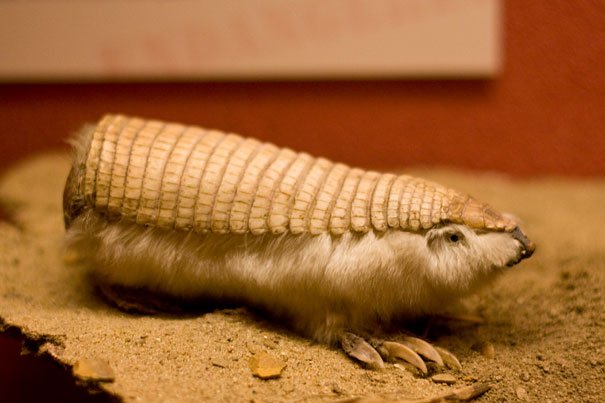
The pink fairy armadillo (Chlamyphorus truncatus) or pichiciego is the smallest species of armadillo (mammals of the families Chlamyphoridae and Dasypodidae, recognized by a bony armor shell), first described by R. Harlan in 1825. This desert-adapted animal is endemic to central Argentina and can be found inhabiting sandy plains, dunes, and scrubby grasslands.
Pink fairy armadillos have small eyes, silky yellowish white fur, and a flexible dorsal shell that is solely attached to its body by a thin dorsal membrane. In addition, its spatula-shaped tail protrudes from a vertical plate at the blunt rear of its shell. This creature exhibits nocturnal and solitary habits and has a diet that is mainly composed of insects, worms, snails, and various plant parts.
The conservation status for pink fairy armadillo is still uncertain, and it is listed as Data Deficient by the I'UCN Red List of Threatened Species. The decline in population for this species has generally been attributed to farming activities and predators including domestic dogs and cats. Pink fairy armadillos are found less commonly than they were a few decades ago, and the field sightings have been rare and incidental. Individuals that have been caught in the wild had a tendency to die during or a couple days after they were transported from their natural habitat to captive facilities. There is a sole record for the longevity of a pink fairy armadillo that was held in captivity more than 4 years; however, that particular case lacks proper scientific description and thus cannot be considered fully valid. Armadillos' evolutionary distinctiveness, combined with their restricted geographic range, ongoing threats, and rarity makes the urgent conservation attention extremely important for these species.
Aye-aye
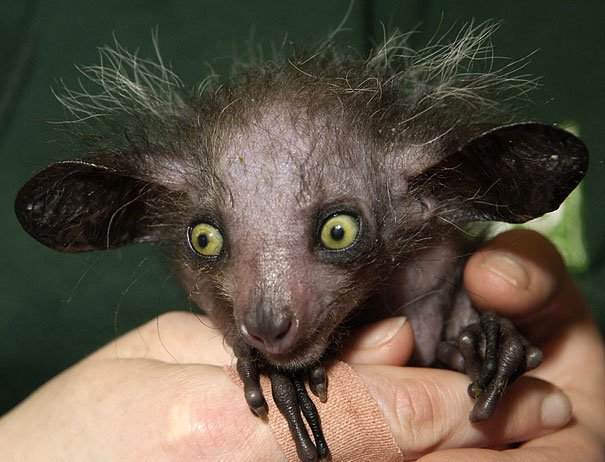
Aye-Aye1 (Daubentonia madagascariensis) is a species of strepsirrhinian primate that lives in Madagascar. It is the only species of the genus Daubentonia, itself the sole member of the daubentonidae family. It is considered vulnerable to extinction according to I'UCN.
It measures 75 to 90 cm in length - of which 44 to 53 for the tail - and weighs from 2 to 3 kg. Both sexes are apparently impossible to identify.
Daubentonia madagascariensis, commonly called aye-aye by local populations, holds a very special place in the Malagasy bestiary. Many legends run on this animal with nocturnal manners. While the number of individuals has fallen in recent decades, the myth of the evil animal has been preserved, transmitted from generation to generation. It is thus considered that it bears misfortune if it appears in or around the dwellings and that it possesses powers of sorcery thanks to its disproportionate greater, of which the soothsayers are used.
The Maned Wolf
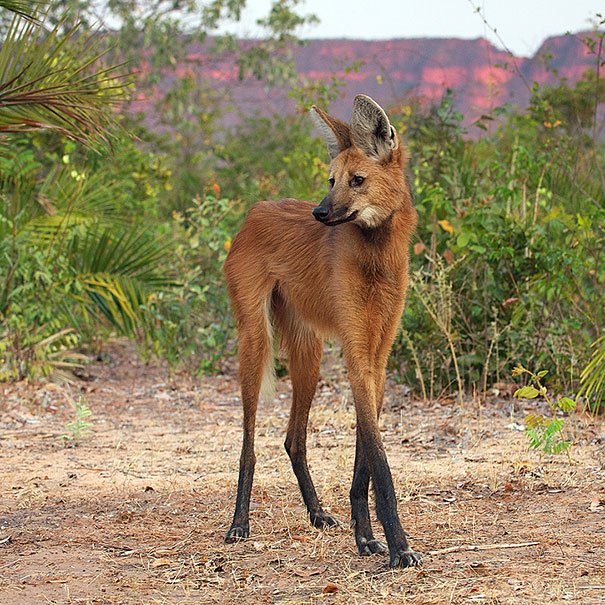
The maned wolf (Chrysocyon brachyurus) is the largest canid of South America. Its markings resemble those of foxes, but it is not a fox, nor is it a wolf, as it is not closely related to other canids. It is the only species in the genus Chrysocyon (meaning "golden dog").
This mammal is found in open and semi-open habitats, especially grasslands with scattered bushes and trees, in south, central-west, and southeastern Brazil, Paraguay, northern Argentina, Bolivia east and north of the Andes, and far southeastern Peru (Pampas del Heath only). It is very rare in Uruguay, possibly being displaced completely through loss of habitat. I'UCN lists it as near threatened, while it is considered a vulnerable species by the Brazilian government (IBAMA).
Unlike other large canids (such as the gray wolf, the African hunting dog, or the dhole) the maned wolf does not form packs.[6] It hunts alone, usually between sundown and midnight. Maned wolves rotate their large ears to listen for prey animals in the grass. They tap the ground with a front foot to flush out the prey and pounce to catch it. It kills its prey by biting on the neck or back, and shaking the prey violently if necessary. Monogamous pairs may defend a shared territory of approximately 30 km2 (12 sq mi), although outside of mating, the individuals may meet seldom. The territory is crisscrossed by paths that the maned wolves create as they patrol at night. Several adults may congregate in the presence of a plentiful food source, for example, a fire-cleared patch of grassland that would leave small vertebrate prey exposed while foraging.
Tufted Deer
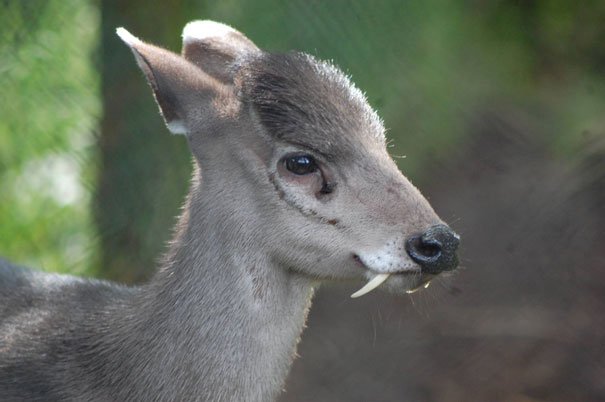
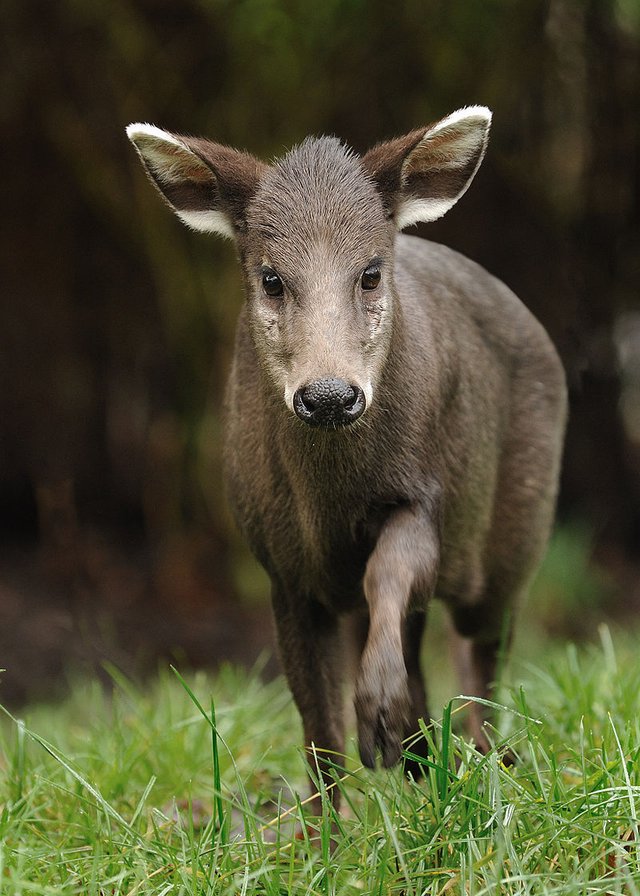
The tufted deer (Elaphodus cephalophus) is a small species of deer characterized by a prominent tuft of black hair on its forehead and fang-like canines for the males. It is a close relative of the muntjac, living somewhat further north over a wide area of central China northeastern Myanmar. Suffering from overhunting and habitat loss, this deer is considered near-threatened. It is the only member of the genus Elaphodus. It is restricted to forested mountain habitat up to 4500 m above sea level, making study difficult.
The tufted deer is similar to a muntjac in appearance, but the longer necks and legs give it a slightly leaner appearance. The coat is coarse with short and stiff hairs, being almost black in the winter and chocolate brown in the summer. The lips, tip of the ears, and the underside of the tails are white. A tuft of horseshoe-shaped hair is present on the forehead and upper neck, being brown to black, and can be up to 17 centimetres (6.7 in) long.
Perhaps the most striking feature of this deer is the fang-like canines in the males of the species. These can grow up to 2.6 cm (1.0 in) long, or longer in rare cases.
The tufted deer is a small deer, but still larger than most muntjac species. It stands at 50–70 centimetres (20–28 in) at the shoulder, and the weight varies from 17 to 30 kilograms (37 to 66 lb). The tail is short at around 10 cm (3.9 in). The antler is only present in males and is extremely short, almost hidden by its long tuft of hair.
Dumbo Octopus
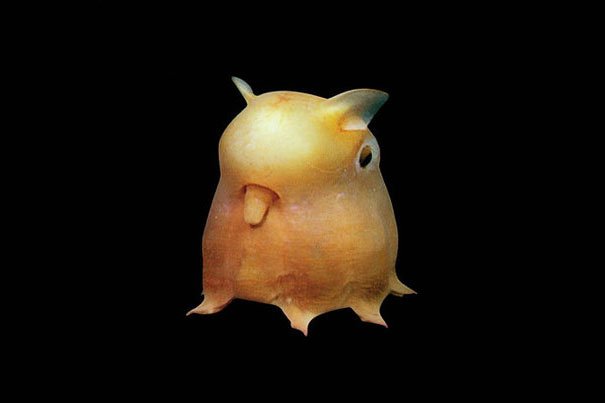
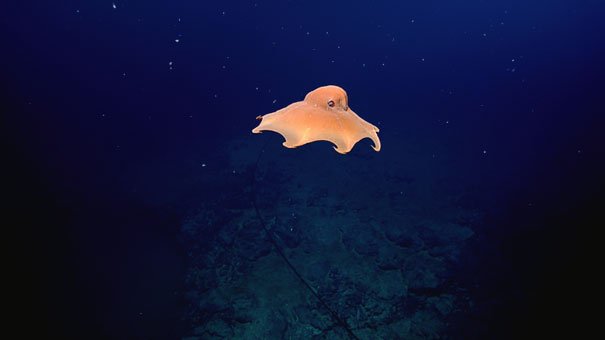
Grimpoteuthis, also called the Dumbo octopus, is a genus of pelagic umbrella octopus, so named for the prominent ear-like fins which characteristically protrude from the mantle just above the eyes and which give a vague resemblance to the ears of Walt Disney's flying elephant Dumbo. There are 13 species recognized in the genus, Prey include crustaceans, bivalves, worms and copepods. The average life span of various Grimpoteuthis species is 3 to 5 years.
All species of Grimpoteuthis live at depths of 3,000 to 4,000 metres (9,800 to 13,100 ft) with some living up to 7,000 metres (23,000 ft) below sea level, which is the deepest of any known octopus. They are some of the rarest of the Octopoda species though they occur worldwide including in the waters of New Zealand, Australia, Monterey Bay, Oregon, Philippines, Martha's Vineyard, Papua New Guinea and Azores. The largest Dumbo octopus ever recorded was 1.8 metres (5.9 ft) in length and weighed 5.9 kilograms (13 lb). The average size for most species is 20–30 centimetres (7.9–12 in) in length. The average weight is still undetermined.
Breeding:
Females have no distinct period for breeding. Females carry multiple eggs in various stages of maturation, suggesting that they have no optimal breeding period. Male octopuses have a separate protuberance on one of their arms that carries an encapsulated sperm packet to the female. It is hypothesized that the female can then distribute this sperm to the eggs at any given time based on environmental conditions. The females lay the eggs under small rocks or on shells in the deep ocean or can even carry them on her arms, by tucking the eggs behind the wide webbing, until she finds a safe place that would provide them with the best fitness. As with other octopuses, females do not invest any further time in the young after they hatch because once they are born they are able to defend themselves.
Patagonian Mara
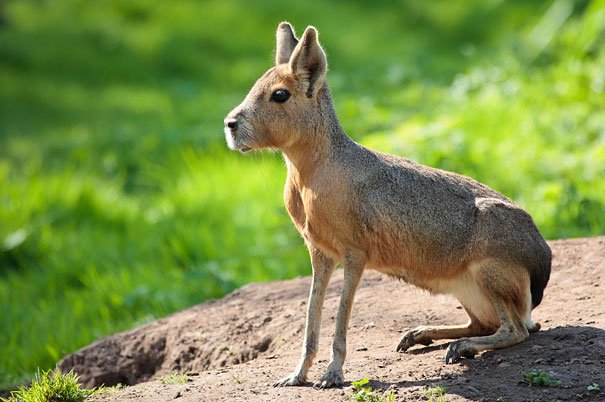

Image : Young mara and older one sniffing each other. From the zoological garden of the Jardin des Plantes in Paris.
The Patagonian mara (Dolichotis patagonum) is a relatively large rodent in the mara genus (Dolichotis). It is also known as the Patagonian cavy, Patagonian hare or dillaby. This herbivorous, somewhat rabbit-like animal is found in open and semi-open habitats in Argentina, including large parts of Patagonia. It is monogamous, but often breeds in warrens that are shared by several pairs.
The Patagonian mara resembles a jackrabbit. It has distinctive long ears and long limbs. Its hind limbs are longer and more muscular than its forelimbs and it has a longer radius than humerus. The feet are compressed, making them hoof-like. The forefeet have 4 digits while the hind feet have 3 digits. Its tail is short, depressed and almost hairless. It has a gray dorsal pelage with a white patch on the rump separated from the dorsal fur by a black area. In addition, the mara has a white underside with a somewhat orange flank and chin. The mara has a head and body length of 69–75 centimetres (27–30 in) with a tail of 4–5 centimetres (1.6–2.0 in). It weighs 8–16 kilograms (18–35 lb). Unlike most other cavids, the anal glands of the mara are between the anus and the base of the tail rather than being anterior to the anus.
The social organizations have a unique combination of monogamy and communal breeding. Being monogamous, pairs of maras stay together for life with replacement of partners only occurring after its death. The male has almost the sole responsibility in maintaining the pair by following the female wherever she goes. A male will mark his female with urine and mark the ground around her with secretions from his glands and with feces, making the grounds around the female a mobile territory. Pairs will breed together alone or with other pairs in warrens shared by up to 29 pairs. Maras breed, at least in southern Argentina, from August to January. Gestation lasts 100 days in wild. Most births in Patagonia occur between September and October which is before the summer dry season and after the winter rains. Female produce one litter each year in the wild, but can produce as many as four litters a year in captivity. Young can walk almost immediately postpartum.
Star-nosed mole

The star-nosed mole (Condylura cristata) is a small mole found in wet low areas in the northern parts of America. It is the only member of the tribe Condylurini and the genus Condylura.
The star-nosed mole is easily identifiable by the twenty-two pink fleshy appendages ringing its snout which is used as a touch organ with more than 25,000-minute sensory receptors, known as Eimer's organs, with which this hamster-sized mole feels its way around. With the help of its Eimer's organs, it may be perfectly poised to detect seismic wave vibrations.
Description:
The star-nosed mole is covered in thick, blackish-brown, water-repellent fur, and has large scaled feet and a long, thick tail, which appears to function as a fat storage reserve for the spring breeding season. Adults are 15 to 20 cm (5.9 to 7.9 in) in length, weigh about 55 grams (2 oz), and have 44 teeth. The mole's most distinctive feature is a circle of 22 mobile, pink, fleshy tentacles (called rays) at the end of its snout, from which it derives its name. These are used to identify food by touch, such as worms, insects and crustaceans.
Current applications in engineering:
The study of highly specialized systems often allows better insight into more generalized ones. The mole's striking, star-like structure may reflect a general trend in its "less remarkable" relatives, including humans. Little is known today about the molecular mechanisms of tactile transduction in mammals. As the drosophila fly is to genetics, or the squid giant axon, is to neurobiology, the star-nosed mole may be the model organism for tactile transduction. The proper understanding of its saccade-like system and associated transduction may lead in future to the development of new types of neural prosthesis. Furthermore, the outstanding speed and precision at which the mole performs may provide insights into the structural design of intelligent machines as an artificial response to the remarkable sensory ability of the star-nosed mole.
If you liked the publication, please support me with upvote or resteem or comment.
actually now that i have checked it more closely disregard my last comment.
The pictures are taken directly from a boredpanda article which i dont have much issue with but the information is a direct copy paste from the wikipedia page.
that is plagiarism at its finest.
Downvoting a post can decrease pending rewards and make it less visible. Common reasons:
Submit
Even if it is plagiarism, but I put this information for the benefit of people, take care of your affairs and do not interfere in what does not concern you idiot
Downvoting a post can decrease pending rewards and make it less visible. Common reasons:
Submit
no you put this here for the benefit of you to try and make money. I will interfere as i see fit, plagiarism is a big issue especially when you're trying to make money off of other peoples work.
Downvoting a post can decrease pending rewards and make it less visible. Common reasons:
Submit
What you are doing now we call pimp, so its not your business sucker
Downvoting a post can decrease pending rewards and make it less visible. Common reasons:
Submit
Listen, the first rule of steemit is to produce your original content, if you are copying from other site than give a source link along with it than its fine. If you act rude and go in a downvote war, you probably not gonna mess with that bigdizzle.
Downvoting a post can decrease pending rewards and make it less visible. Common reasons:
Submit
But I give the source !!!! why you flag me??
Downvoting a post can decrease pending rewards and make it less visible. Common reasons:
Submit
This post was resteemed by @resteembot!
Good Luck!
Curious? Check out:
The @resteembot users are a small but growing community.
Check out the other resteemed posts in resteembot's feed.
Some of them are truly great.
Downvoting a post can decrease pending rewards and make it less visible. Common reasons:
Submit
This post was resteemed by @resteembot!
Good Luck!
Curious? Check out:
The @resteembot users are a small but growing community.
Check out the other resteemed posts in resteembot's feed.
Some of them are truly great.
Downvoting a post can decrease pending rewards and make it less visible. Common reasons:
Submit
@originalworks
Downvoting a post can decrease pending rewards and make it less visible. Common reasons:
Submit
The @OriginalWorks bot has determined this post by @sparganose to be original material and upvoted it!
To call @OriginalWorks, simply reply to any post with @originalworks or !originalworks in your message!
To enter this post into the daily RESTEEM contest, upvote this comment! The user with the most upvotes on their @OriginalWorks comment will win!
For more information, Click Here!
Special thanks to @reggaemuffin for being a supporter! Vote him as a witness to help make Steemit a better place!
Downvoting a post can decrease pending rewards and make it less visible. Common reasons:
Submit
i like the info you put but you should probably mix it up a little because its essentially just copying a list from
https://www.boredpanda.com/strange-animals/
good writing though
Downvoting a post can decrease pending rewards and make it less visible. Common reasons:
Submit
Those are some weird animal
Downvoting a post can decrease pending rewards and make it less visible. Common reasons:
Submit
wow! unique animals
Downvoting a post can decrease pending rewards and make it less visible. Common reasons:
Submit